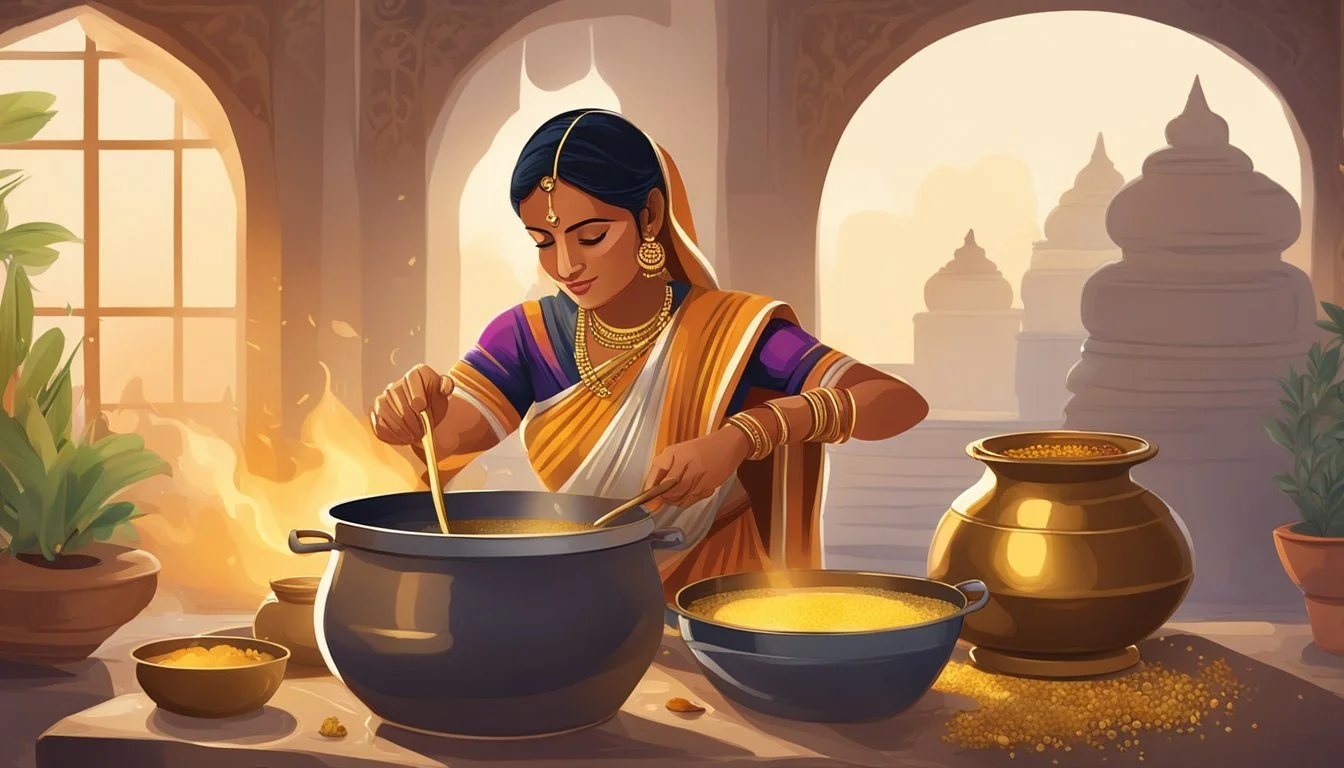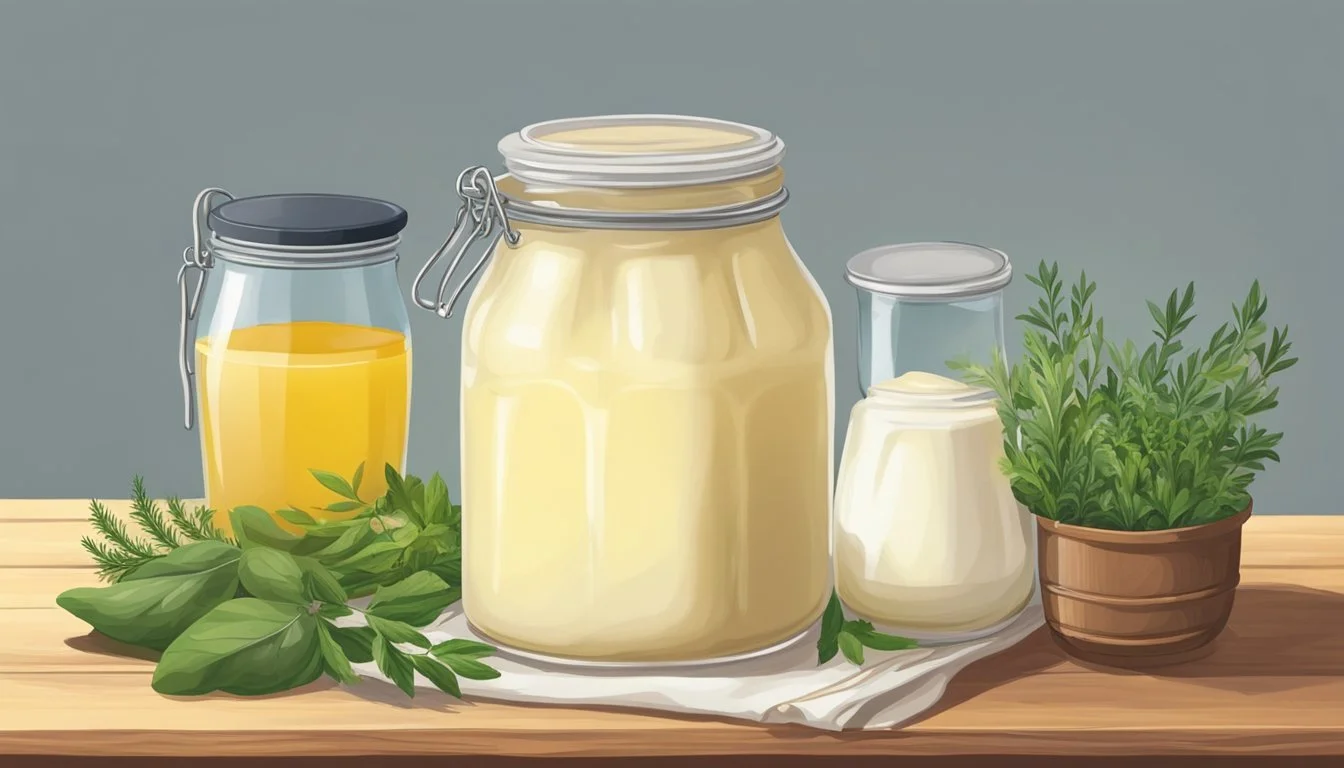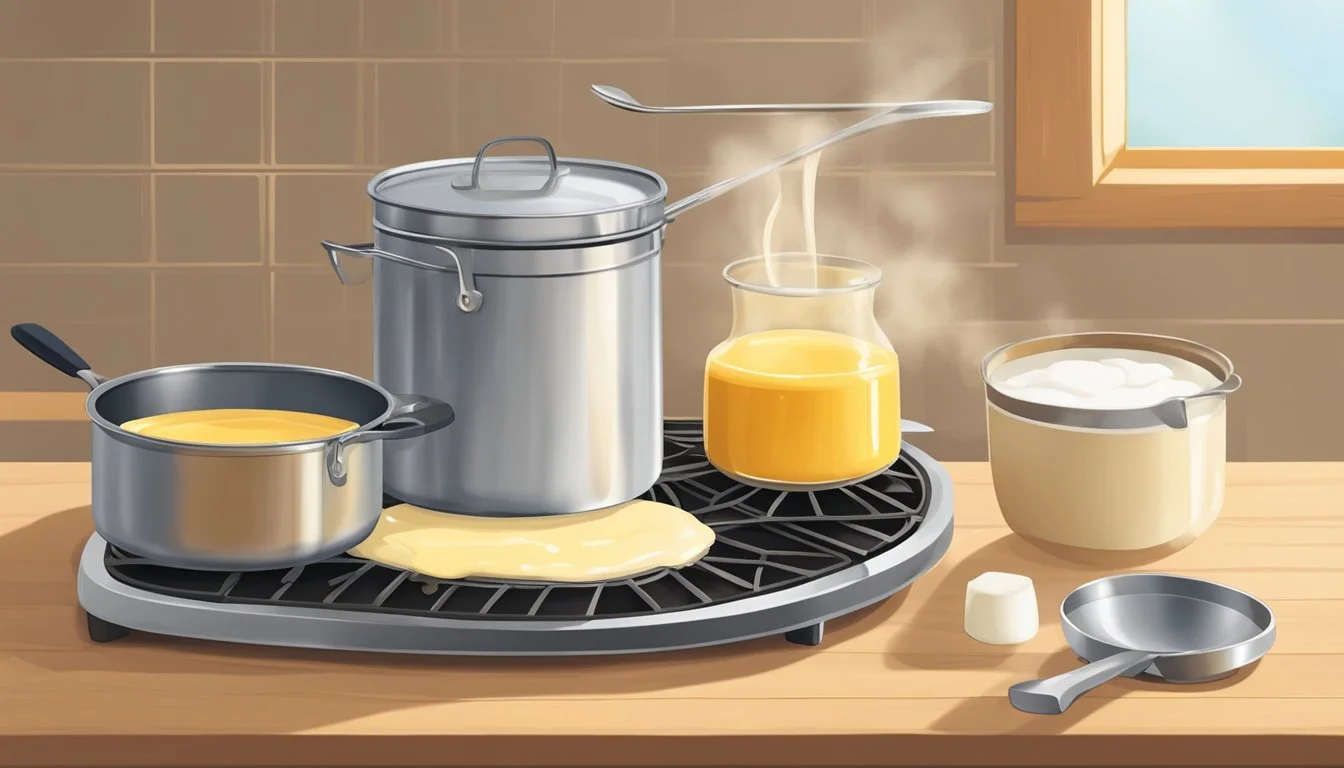The Art of Raw Milk Ghee
Traditional Methods and Nutritional Advantages
Ghee, the clarified butter traditionally used in Indian cooking, has a rich history that is as much about culture as it is about health. It is made by slowly melting butter and removing the milk solids that rise to the top, leaving behind the pure golden oil. This process not only enhances ghee's flavor, making it nutty and intense but also extends its shelf life significantly, allowing it to be stored without refrigeration. Revered in Ayurvedic medicine for its medicinal properties, ghee is considered more than just a cooking ingredient; it is a potent substance thought to promote health and healing.
The health benefits of ghee are rooted in its nutritional profile rich in vitamins A, D, E, and K, all of which are fat-soluble and more readily absorbed by the body when taken with fats like ghee. It also contains butyric acid, a short-chain fatty acid beneficial for maintaining gut health, and linoleic acid, which has anti-inflammatory properties. The omega-3 and omega-6 fatty acids present in ghee contribute to these anti-inflammatory benefits and help in the management of joint pain. As modern diets embrace fats that provide functional benefits, ghee is gaining popularity not only in traditional dishes but also as a health supplement.
When sourced from grass-fed cows, the nutritional value of ghee improves even further due to the higher presence of conjugated linoleic acid and omega-3 fatty acids in the cows' milk. These compounds are associated with a multitude of health benefits, ranging from improved heart health to reduced inflammation. Raw milk ghee, made using unpasteurized milk, is thought to retain even more of the milk's original nutrients and enzymes, potentially amplifying ghee's natural benefits. With its roots in age-old traditions and its alignment with modern nutrition science, raw milk ghee represents a confluence of art and wellness, a testament to the enduring wisdom of traditional food practices.
"The Art of Raw Milk Ghee" celebrates the timeless tradition of crafting this golden elixir from pure, unadulterated raw milk. This enlightening guide takes readers on a transformative raw milk journey through the process of churning raw milk into ghee, unlocking its rich flavors and aromatic essence.
The book explores the profound impact of raw milk diet on overall well-being, shedding light on the potential benefits of incorporating raw milk ghee as a source of essential nutrients and healthy fats. It also delves into the significance of raw milk nutritional deficiencies and how ghee, derived from raw milk, can address these dietary gaps, particularly for individuals seeking a holistic approach to nutrition.
Furthermore, "The Art of Raw Milk Ghee" offers valuable insights into raw milk infant nutrition, providing a nuanced perspective on the potential role of ghee in early childhood diets. It also highlights the artisanal craft of ghee-making, drawing parallels to the meticulous artistry of raw milk cheese-making and its cultural significance.
In essence, "The Art of Raw Milk Ghee" is an inspiring tribute to the art and science of ghee production, showcasing the profound connection between raw milk and this revered culinary treasure, especially in the context of addressing the nutritional needs of an aging population.
Origins and Cultural Significance
Ghee, the clarified butter predominantly used in Indian and Middle Eastern cuisines, has an extensive history rooted in cultural practices and traditional medicine, particularly Ayurveda.
Historical Context of Ghee
India: Ghee dates back to ancient India's Vedic period, where it was highly prized both as a food source and a sacred medium in religious rituals. The preparation of ghee involves a traditional process of slowly simmering butter to separate the milk solids from the liquid fat, resulting in a pure, golden oil with a distinct flavor and extended shelf life.
Ghee in Ayurveda and Traditional Medicine
Ayurveda: Recognized as a powerful health tonic within Ayurvedic medicine, ghee is believed to promote digestion, rejuvenate the body, and enhance mental clarity. Ayurvedic texts attribute various therapeutic properties to the different components of ghee, considering it a holistic remedy for various ailments.
Ghee Across Different Cuisines
Indian Cuisines: Ghee is a staple in Indian cooking, favored for its nutty flavor and high smoke point, making it an ideal medium for sautéing and frying spices.
Middle Eastern Cuisines: Beyond India, ghee also features in Middle Eastern cuisines, where it enriches the flavor profiles of traditional dishes such as biryanis and stews.
Nutritional Profile of Ghee
Ghee consists of a complex matrix of fats, vitamins, and minerals. Often acclaimed for its nutrient-rich profile, it provides a range of healthful substances, including various types of fatty acids and fat-soluble vitamins.
Fats and Fatty Acids Content
Ghee is rich in saturated fats, with about 65% of its total fat content being saturated. Of particular interest are the medium-chain fatty acids, such as capric acid and lauric acid, which are metabolized differently by the body, offering quick energy.
Monounsaturated Fats: Approximately 25% of ghee's fat content
Polyunsaturated Fats: Around 5% which includes omega-3 fatty acids, important for heart health
Vitamins and Minerals in Ghee
Ghee is an excellent source of fat-soluble vitamins. It contains vitamin A, which is essential for vision and immune function, and vitamin E, known for its antioxidant properties.
Vitamin K: Supports bone health and blood clotting
Vitamin D: For bone health and calcium regulation
Calcium: Trace amounts that contribute to bone structure and function
Comparison With Butter and Other Fats
Compared to butter, ghee has a higher smoke point, making it more stable for cooking at high temperatures. It also doesn't contain casein or lactose, making it a suitable option for those with sensitivities. Here's a quick comparison in calorie content:
Ghee: About 112 calories per tablespoon
Butter: Roughly 100 calories per tablespoon
While both ghee and butter provide cholesterol, ghee's cholesterol levels do not necessarily increase LDL cholesterol levels in the body when consumed in moderation.
The Preparation of Ghee
Ghee, also known as clarified butter, is a staple in culinary traditions around the world, valued for its rich flavor and high smoke point. This section examines how ghee is crafted, from time-honored techniques to modern production methods, while ensuring quality and purity.
Traditional Methods
Traditionally, ghee is made using low heat to simmer butter, allowing the water content to evaporate and the milk solids to separate and settle at the bottom. The process typically begins with churning cream or whole milk into butter, which then undergoes gradual heating until it achieves a golden brown color. This signifies that the milk solids have caramelized, and the remaining liquid is the pure clarified butter. It is crucial to maintain a gentle heat throughout to prevent burning and preserve the nutritional profile.
Steps of Traditional Ghee Making:
Churn fresh cream or whole milk into butter.
Heat the butter gently until milk solids separate.
Skim off the foam that forms on top.
Filter out the golden brown liquid, leaving behind the solids.
Commercial Production Techniques
On a commercial scale, the production of ghee has evolved to include various methods that increase efficiency while striving to maintain product quality. One common approach is the direct cream method, which involves separating fat from milk, then concentrating and heat-treating it to produce ghee. The creamery butter method is another technique, where butter made from cream is processed into ghee. Commercial producers may use specialized equipment to monitor temperatures precisely and automate the skimming and filtering stages.
Commercial Techniques Include:
Direct cream method
Creamery butter method
Pre-stratification process
Quality and Purity Factors
The quality of ghee is directly related to its raw materials and production method. Organic ghee, made from the milk of grass-fed cows, is often considered superior in terms of flavor and nutritional content. Quality control entails careful monitoring throughout the heating process to ensure the final product is free from impurities and has the desired consistency and taste.
Quality Considerations:
Source of milk: Preferably organic and from grass-fed cows
Low heat application to preserve nutrients
Proper separation and removal of milk solids
Final color: A consistent golden brown indicating proper caramelization of solids
Ghee and Health
Ghee's unique composition offers diverse health benefits, acting as a pivotal element in a well-rounded diet and contributing to various aspects of bodily health, from digestion to immune functionality.
Ghee's Role in a Balanced Diet
Ghee, a clarified butter, is rich in fat-soluble vitamins such as Vitamin A, D, E, and K, which are essential for a balanced diet. Its high smoke point ensures that it retains its structural integrity during cooking, preventing the formation of harmful free radicals. Incorporation of ghee within one's diet should be moderated, as the calorie-dense nature of fats can contribute to weight gain if consumed excessively.
Impact on Digestive Health
The consumption of ghee is linked to improved digestion due to its butyric acid content. This short-chain fatty acid helps maintain the integrity of the digestive tract and can ease the process of digestion. Ghee is also thought to stimulate the secretion of stomach acids to aid in digestion, making it beneficial for those with sluggish digestion.
Cardiovascular and Heart Health
The debate on ghee's impact on heart health is nuanced. Ghee contains conjugated linoleic acid (CLA), a type of fatty acid that has been associated with reducing cardiovascular risk. However, ghee is also rich in saturated fats, and excessive intake might influence cholesterol levels. Hence, moderation and balance are key in reaping potential benefits for heart health.
Benefits for Skin and Hair
Ghee is traditionally revered for its positive effects on skin and hair health, owing to its moisturizing and anti-inflammatory properties. Its nutrients can potentially enhance skin barrier function and improve skin hydration, while its use in hair can make it more lustrous and healthy-looking.
Anti-Inflammatory and Immune-Boosting Properties
The anti-inflammatory effects of ghee are attributed to the presence of omega-3 fatty acids. These components can aid in reducing inflammation within the body and support the immune system. Furthermore, it has been suggested that ghee can help alleviate allergies by strengthening the body's response to allergens.
Ghee in Diet and Cooking
Ghee is a versatile ingredient in culinary practices, esteemed for its high smoke point and rich flavor. It adapts well to various cooking methods and diet preferences.
Ideal Scenarios for Using Ghee
In a kitchen setting, one may consider ghee a go-to cooking fat for diverse cuisines. It is particularly excellent when stirred into rice or used as a base for spices in Indian dishes. Ghee's versatility extends to being spread on breads or drizzled over popcorn, imparting a buttery taste without the need for actual butter. Within dietary frameworks, those following a Paleo or ketogenic diet often turn to ghee as it aligns with their high-fat, low-carbohydrate preferences.
Ghee's High Smoke Point and Cooking
The high smoke point of ghee, typically around 482°F (250°C), makes it an excellent choice for sautéing and frying. Unlike many oils that start to break down at high temperatures, ghee remains stable, resulting in a reduced likelihood of forming harmful free radicals. This characteristic ensures that vegetables sautéed in ghee are cooked thoroughly without compromising their nutritional integrity.
Culinary Pairings and Substitutions
Ghee offers rich, nutty undertones, complementing an array of ingredients. It can transform simple dishes with its depth of flavor, working effectively with spices and vegetables. For those out of ghee or preferring an alternative, olive oil is a suitable substitute in most recipes; however, the latter should be used sparingly as it has a lower smoke point. Here's a simple substitution guide:
Ingredient Replaced Substitute Ratio Note Butter Ghee 1:1 For baking, ensures a flaky texture. Olive Oil Ghee (for high-heat cooking) Varies* *Use less ghee due to its richness. Vegetable Oil Ghee Varies* *Use less ghee; ideal for high smoke point needs.
In baking, a teaspoon of ghee can replace butter in a 1:1 ratio to achieve a similar flavor and texture. When it comes to other dairy products, ghee serves as both a substitute and a complementary fat, enhancing both savor and nutritional profile.
Potential Risks and Considerations
While ghee has been hailed for its potential health benefits, it is necessary to consider the potential risks and appropriate consumption practices to ensure it is a beneficial addition to one's diet.
When to Avoid Ghee
People with certain health conditions should exercise caution or avoid ghee. Individuals with cardiovascular diseases may need to limit their intake due to ghee's high concentration of saturated fat, which can influence blood cholesterol levels. Persons diagnosed with obesity or those trying to manage their weight should be mindful of ghee's high caloric density.
Managing Portions and Consumption
The key to incorporating ghee into a diet is managing portions to avoid the risks associated with high fat intake. Excessive consumption can lead to increased levels of triglycerides and cholesterol, which are risk factors for heart disease. It's crucial that individuals:
Measure servings to maintain a balance of dairy fat.
Integrate ghee into a diet that includes a variety of healthy fats.
Ghee and Dairy Allergies
Ghee is a dairy product and, as such, can be problematic for those with dairy allergies or lactose intolerance. While it is lower in lactose because of the removal of milk solids, there can still be traces present. Therefore, individuals with severe dairy allergies should avoid ghee, and those lactose intolerant should proceed with caution to prevent adverse reactions.
Scientific Research and Studies
Raw milk ghee, clarified butter traditionally used in Asian and Middle Eastern cuisines, has been the subject of various scientific studies. These studies scrutinize its constituents, particularly fatty acids, and explore the range of health benefits and therapeutic potential attributed to its consumption.
Investigations into Fatty Acids
Scientific research underscores the complex composition of ghee, revealing that it contains a variety of fatty acids, both saturated and unsaturated. These studies detail that the primary fatty acids in ghee include butyric acid, palmitic acid, and oleic acid, among others. The presence of butyric acid is of particular interest due to its potential beneficial effects on gastrointestinal health.
Saturated Fatty Acids: Known for their controversial role in cardiovascular health, saturated fatty acids in ghee have been examined to understand their impact. Contrasting results indicate a nuanced relationship depending on the broader dietary context.
Unsaturated Fatty Acids: These, particularly oleic acid, are lauded for their positive role in maintaining heart health, as they may help in reducing inflammation and cholesterol levels.
Studies on Health Benefits and Therapeutic Potential
The nutritional profile of ghee, enriched with fat-soluble vitamins like vitamins A, E, and D, broadens its function beyond a simple culinary ingredient. A notable point of interest is its role in cognitive health, as suggested by Ayurvedic literature and supported by contemporary studies highlighting possible cognitive benefits including enhanced memory and intellect.
Cognitive Benefits: Researchers pay attention to the therapeutic potential of ghee in neurological health, investigating claims of its efficacy in improving mental clarity and memory function.
Gastrointestinal Health: Functional benefits have been associated with ghee in terms of digestive health, attributed largely to its content of butyric acid, which may help maintain the integrity of gut lining and support healthy gut flora.
In summary, scientific studies investigate the relationship between ghee's fatty acid composition and its health impacts, from nourishing the gastrointestinal tract to possibly bolstering cognitive function.
Ghee and Holistic Wellbeing
Ghee is not only a dietary staple but also a cornerstone in holistic health disciplines like Ayurveda. It is revered for its contribution to both physical and mental wellness, as well as spiritual upliftment.
Ghee in Mind-Body Practices
Ayurveda regards ghee as a potent enhancer of Ojas, the essence of immunity and vitality. Through its nurturing properties, ghee bolsters overall health and is considered one of the most sattvic foods, promoting energy levels, balance, and healing. In mind-body practices, its use extends to improving mental clarity and cognitive function.
The inclusion of ghee in Ayurvedic medicine is profound, with ancient texts citing it over 700 times in the context of therapeutic applications. Notably, it is highlighted for its cognitive benefits, being part of treatments for conditions affecting the mind.
The Spiritual Aspect of Ghee
In spiritual practices, ghee holds a significant place. It is used in rituals and ceremonies as a symbol of purification and enlightenment. The qualities of ghee, such as its clarity and consistency, are believed to reflect in the one who consumes it, nurturing the spiritual aspects of life.
The use of ghee transcends dietary purposes, entering the realm of spiritual symbols and practices. It's believed to elevate the sattvic quality in practitioners, fostering a serene, meditative state conducive to spiritual growth.






